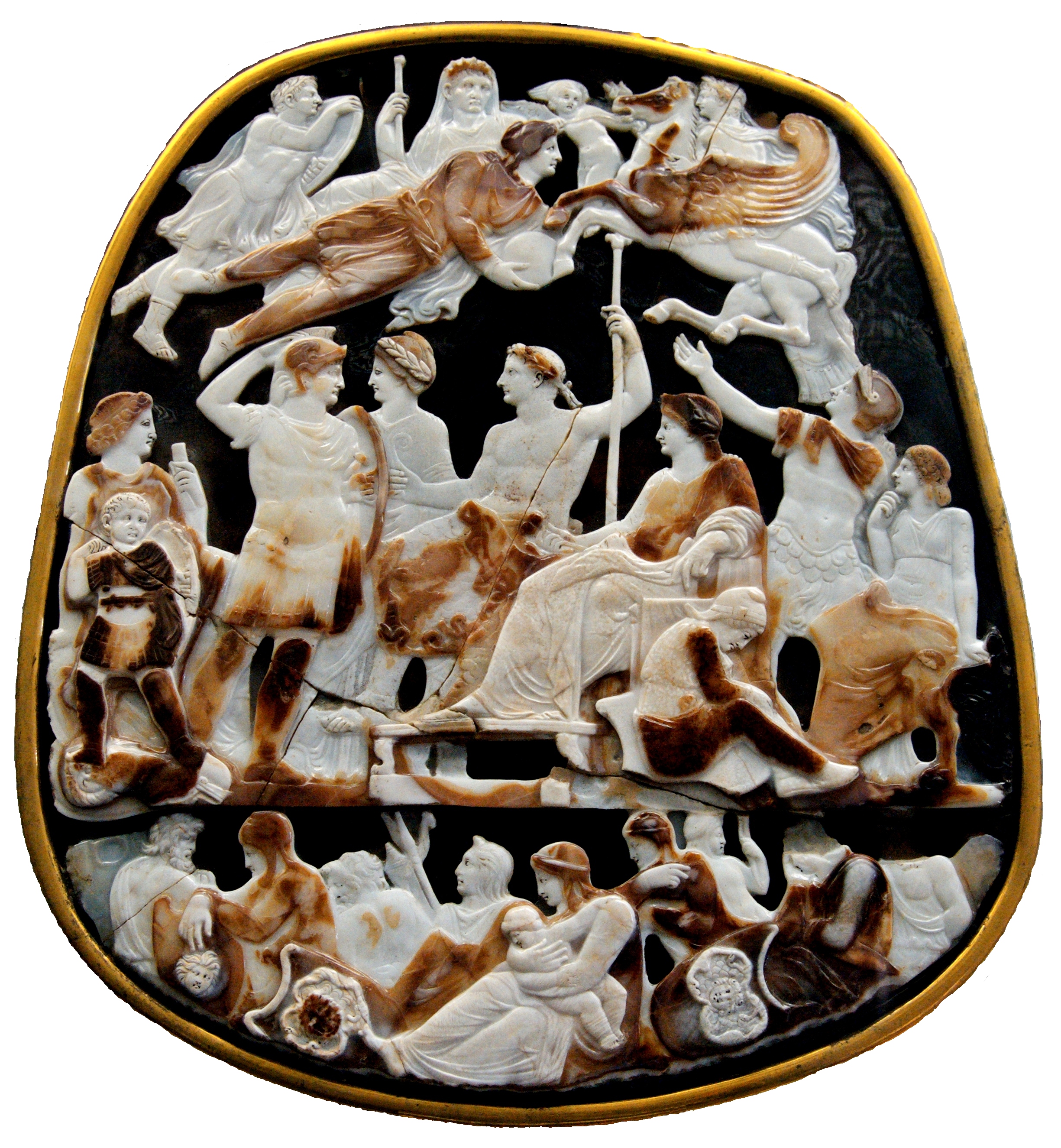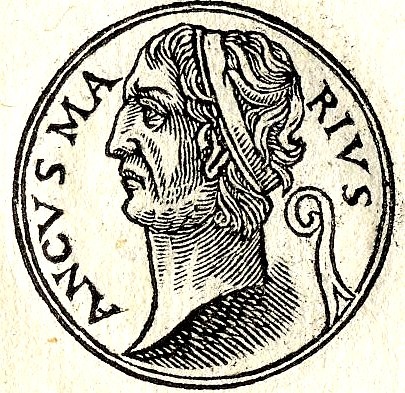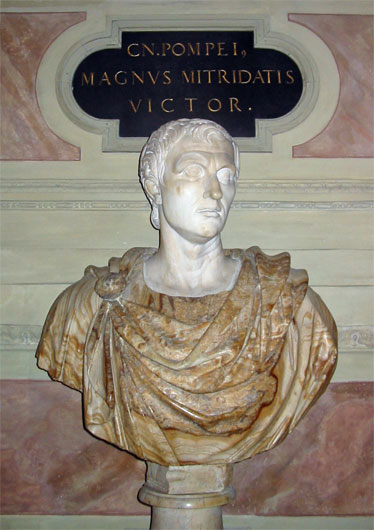|
Julia (wife Of Marius)
Julia ( – 69 BC) was the wife of the Roman consul Gaius Marius and a paternal aunt of future Roman dictator Julius Caesar. Biography Julia was the daughter of Gaius Julius Caesar and Marcia (daughter of praetor Quintus Marcius Rex). She was a sister of Gaius Julius Caesar (the father of Julius Caesar) and Sextus Julius Caesar, consul in 91 BC. At about 110 BC she married Gaius Marius. They had a son, Gaius Marius the Younger. Plutarch also mentions that Marius had two step-sons named Quintus Granius and Gnaeus Granius; it is possible that these men were children of Julia by an earlier marriage or step-children of Marius from a marriage to another woman before Julia. If Quintus and Gnaeus were indeed Julia's sons, then her earlier husband was likely a member of the Campanian trading family since Julia was a patrician and would only have married someone from the Grania gens if they were very rich. According to Plutarch, it was by marrying her, a patrician woman, that the ... [...More Info...] [...Related Items...] OR: [Wikipedia] [Google] [Baidu] |
Bas-relief
Relief is a sculptural method in which the sculpted pieces remain attached to a solid background of the same material. The term ''relief'' is from the Latin verb , to raise (). To create a sculpture in relief is to give the impression that the sculpted material has been raised above the background plane. When a relief is carved into a flat surface of stone (relief sculpture) or wood ( relief carving), the field is actually lowered, leaving the unsculpted areas seeming higher. The approach requires chiselling away of the background, which can be time-intensive. On the other hand, a relief saves forming the rear of a subject, and is less fragile and more securely fixed than a sculpture in the round, especially one of a standing figure where the ankles are a potential weak point, particularly in stone. In other materials such as metal, clay, plaster stucco, ceramics or papier-mâché the form can be simply added to or raised up from the background. Monumental bronze reliefs are ... [...More Info...] [...Related Items...] OR: [Wikipedia] [Google] [Baidu] |
Laudatio Iuliae Amitae
The ''laudatio Iuliae amitae'' ("Eulogy for Aunt Julia") is a funeral oration that Julius Caesar said in 68 BC to honor his dead aunt Julia, the widow of Marius. The introduction of this '' laudatio funebris'' is reproduced in the work ''Divus Iulius'' by the Roman historian Suetonius Gaius Suetonius Tranquillus (), commonly referred to as Suetonius ( ; – after AD 122), was a Roman historian who wrote during the early Imperial era of the Roman Empire. His most important surviving work is ''De vita Caesarum'', common ...: See also * Poetry by Julius Caesar References Works by Julius Caesar Funeral orations Ancient Roman speeches {{Speech-stub ... [...More Info...] [...Related Items...] OR: [Wikipedia] [Google] [Baidu] |
1st-century BC Roman Women
File:1st century collage.png, From top left, clockwise: Jesus is crucified by Roman authorities in Judaea (17th century painting). Four different men ( Galba, Otho, Vitellius, and Vespasian) claim the title of Emperor within the span of a year; The Great Fire of Rome (18th-century painting) sees the destruction of two-thirds of the city, precipitating the empire's first persecution against Christians, who are blamed for the disaster; The Roman Colosseum is built and holds its inaugural games; Roman forces besiege Jerusalem during the First Jewish–Roman War (19th-century painting); The Trưng sisters lead a rebellion against the Chinese Han dynasty (anachronistic depiction); Boudica, queen of the British Iceni leads a rebellion against Rome (19th-century statue); Knife-shaped coin of the Xin dynasty., 335px rect 30 30 737 1077 Crucifixion of Jesus rect 767 30 1815 1077 Year of the Four Emperors rect 1846 30 3223 1077 Great Fire of Rome rect 30 1108 1106 2155 Boudican re ... [...More Info...] [...Related Items...] OR: [Wikipedia] [Google] [Baidu] |
69 BC Deaths
69 may refer to: * 69 (number) * A year, primarily 69 BC, AD 69, 1969, or 2069 *69 (sex position) * 69 Hesperia, a main-belt asteroid Arts and media Music * ''69'', a 1988 album by A.R. Kane * 69", a song by Deep Purple from ''Abandon'' * Major 6 add 9, a jazz chord * "Summer of '69", a song by Bryan Adams * 6ix9ine, also known as Tekashi69, American rapper * ''Day69'', album by 6ix9ine * "69", a song by T-Pain from his 2007 album '' Epiphany'' * ''Six/Nine'', a 1995 album by Buck-Tick Other media * ''69'', a novel by Ryu Murakami * ''69'', a 2004 film based on the Murakami novel Other uses * Lake 69, a small lake in the region of Áncash, Peru * *69, the Last Call Return feature code in the US and Canada * List of highways numbered 69 ** Texas State Highway 112, formerly designated as State Highway 69 * ♋️, the symbol for the astrological sign Cancer * British Rail Class 69, a class of locomotive converted from the ageing British Rail Class 56 The British Rail C ... [...More Info...] [...Related Items...] OR: [Wikipedia] [Google] [Baidu] |
130s BC Births
Thirteen or 13 may refer to: * 13 (number) * Any of the years 13 BC, AD 13, 1913, or 2013 Music Albums * ''13'' (Black Sabbath album), 2013 * ''13'' (Blur album), 1999 * ''13'' (Borgeous album), 2016 * ''13'' (Brian Setzer album), 2006 * ''13'' (Die Ärzte album), 1998 * ''13'' (The Doors album), 1970 * ''13'' (Havoc album), 2013 * ''13'' (HLAH album), 1993 * ''13'' (Indochine album), 2017 * ''13'' (Marta Savić album), 2011 * ''13'' (Norman Westberg album), 2015 * ''13'' (Ozark Mountain Daredevils album), 1997 * ''13'' (Six Feet Under album), 2005 * ''13'' (Suicidal Tendencies album), 2013 * ''13'' (Solace album), 2003 * ''13'' (Second Coming album), 2003 * 13 (Timati album), 2013 * ''13'' (Ces Cru EP), 2012 * ''13'' (Denzel Curry EP), 2017 * ''Thirteen'' (CJ & The Satellites album), 2007 * ''Thirteen'' (Emmylou Harris album), 1986 * ''Thirteen'' (Harem Scarem album), 2014 * ''Thirteen'' (James Reyne album), 2012 * ''Thirteen'' (Megadeth album), 2011 * ... [...More Info...] [...Related Items...] OR: [Wikipedia] [Google] [Baidu] |
Julio-Claudian Family Tree
Around the start of the Common Era, the family trees of the gens Julia and the gens Claudia became intertwined into the Julio-Claudian family tree as a result of marriages and adoptions. Descendancy of the emperors of the Julio-Claudian dynasty The Julio-Claudian dynasty was the first dynasty of Roman emperors. All emperors of that dynasty descended from Julii Caesares and/or from Claudii. Marriages between descendants of Sextus Julius Caesar and Claudii had occurred from the late stages of the Roman Republic, but the intertwined Julio-Claudian family tree resulted mostly from adoptions and marriages in Imperial Rome's first decades. Note that descendancy of the Julii Caesares before the generation of Julius Caesar's grandfather is in part conjectural, but as presented by scholars.Smith 1870, Vol. 1 p. 536 ff. , - , style="text-align: left;", Simplified By generation In the Julio-Claudian dynasty of R ... [...More Info...] [...Related Items...] OR: [Wikipedia] [Google] [Baidu] |
Julia Gens
The gens Julia was one of the most prominent patrician families of ancient Rome. From the early decades of the Republic, members of this gens served in the highest offices of the Roman state, beginning with Gaius Julius Iulus, consul in 489 BC. However, the Julii are perhaps best known for Gaius Julius Caesar, the dictator and adoptive father of the emperor Augustus, through whom the name was passed to the Julio-Claudian dynasty of the first century AD. The Julius became very common in imperial times, as the descendants of persons enrolled as citizens under the early emperors began to make their mark in history.Drumann, ''Geschichte Roms'', vol. III, pp. 114–117; Smith, "Julia Gens", in ''Dictionary of Greek and Roman Biography and Mythology'', vol. II, pp. 642, 643; Münzer, "Iulius", in ''Realencyclopädie der Classischen Altertumswissenschaft'', vol. X, half-volume 19, cols. 106, 107. Origin According to Roman tradition, the Julii were among the Alban families b ... [...More Info...] [...Related Items...] OR: [Wikipedia] [Google] [Baidu] |
Women Of The Julii Caesares
Julia (Classical Latin: ''Iulia'') is the nomen of various women of the family Julii Caesares, a branch of the ''gens Julia'', one of the most ancient patrician houses at ancient Rome. By the time of the later Republic, Roman daughters were seldom given personal names, or praenomina, unless there were several sisters in a family, and were instead known by a variety of less formal names when it became necessary to distinguish between them. A first daughter might simply continue to be known by her nomen alone, especially if she were much older than her sisters, or she might become known as ''Julia Major'' ("the elder"), ''Julia Maxima'' ("the eldest"), or ''Julia Prima'' ("the first"). Younger daughters might become known as ''Julia Minor'' ("the younger"), ''Julia Secunda'' ("the second"), ''Julia Tertia'' ("the third"), ''Julia Paulla'' ("little Julia"), and so forth. Outside the family, some women became known by a combination of their father's nomen and cognomen; the daughter ... [...More Info...] [...Related Items...] OR: [Wikipedia] [Google] [Baidu] |
Venus (mythology)
Venus (; ) is a Roman goddess whose functions encompass love, beauty, desire, sex, fertility, prosperity, and victory. In Roman mythology, she was the ancestor of the Roman people through her son, Aeneas, who survived the fall of Troy and fled to Italy. Julius Caesar claimed her as his ancestor. Venus was central to many religious festivals, and was revered in Roman religion under numerous cult titles. The Romans adapted the myths and iconography of her Greek counterpart Aphrodite for Roman art and Latin literature. In the later classical tradition of the West, Venus became one of the most widely referenced deities of Greco-Roman mythology as the embodiment of love and sexuality. As such, she is usually depicted nude. Etymology The Latin theonym and the common noun ('love, charm') stem from a Proto-Italic form reconstructed as ''*wenos-'' ('desire'), itself from Proto-Indo-European (PIE) ' ('desire'; cf. Messapic , Old Indic 'desire'). Derivatives include ''venust ... [...More Info...] [...Related Items...] OR: [Wikipedia] [Google] [Baidu] |
Ancus Marcius
Ancus Marcius () was the Roman mythology, legendary fourth king of Rome, who traditionally reigned 24 years. Upon the death of the previous king, Tullus Hostilius, the Roman Senate appointed an interrex, who in turn called a session of the Roman assemblies, assembly of the people who elected the new king. Ancus is said to have ruled by waging war as Romulus did, while also promoting peace and religion as Numa Pompilius did. Ancus Marcius was believed by many Romans to have been the namesake of the Marcia gens, Marcii, a plebeian family. Background Ancus was the son of Numa Marcius (prefect), Marcius (himself the son of Rome's first ''pontifex maximus'' Numa Marcius) and Pompilia (daughter of Numa Pompilius), Pompilia (daughter of Numa Pompilius).Livy, ''Ab urbe condita libri (Livy), Ab Urbe Condita'', s:From the Founding of the City/Book 1#32, 1:32 Ancus Marcius was thus the grandson of Numa and therefore a Sabines, Sabine. According to Festus (historian), Festus, Marcius was sur ... [...More Info...] [...Related Items...] OR: [Wikipedia] [Google] [Baidu] |
Lives Of The Twelve Caesars
''De vita Caesarum'' (Latin; "About the Life of the Caesars"), commonly known as ''The Twelve Caesars'' or ''The Lives of the Twelve Caesars'', is a set of twelve biographies of Julius Caesar and the first 11 emperors of the Roman Empire written by Suetonius, Gaius Suetonius Tranquillus. The subjects consist of: Julius Caesar (d. 44 BC), Augustus, Tiberius, Caligula, Claudius, Nero, Galba, Otho, Vitellius, Vespasian, Titus, Domitian (d. 96 AD). The work, written in AD 121 during the reign of the emperor Hadrian, was the most popular work of Suetonius, at that time Hadrian's personal secretary, and is the largest among his surviving writings. It was dedicated to a friend, the Praetorian prefect Gaius Septicius Clarus. ''The Twelve Caesars'' was considered very significant in antiquity and remains a primary source on Roman history. The book discusses the significant and critical period of the Principate from the end of the Roman Republic, Republic to the reign of Domitian; compa ... [...More Info...] [...Related Items...] OR: [Wikipedia] [Google] [Baidu] |






